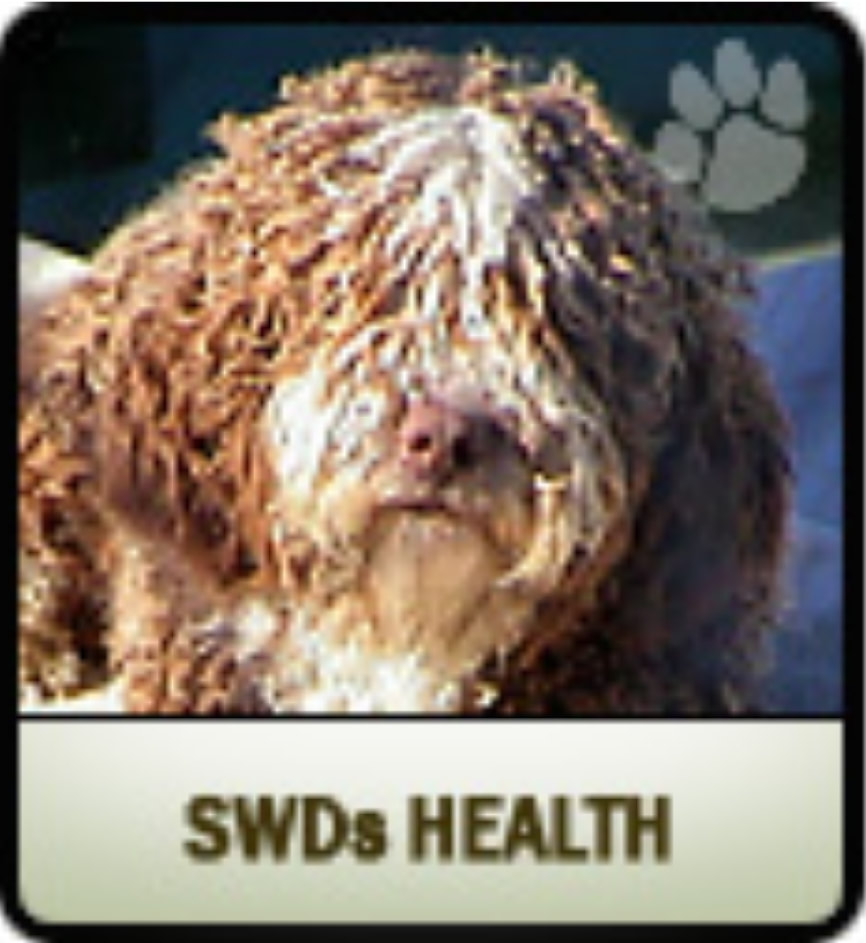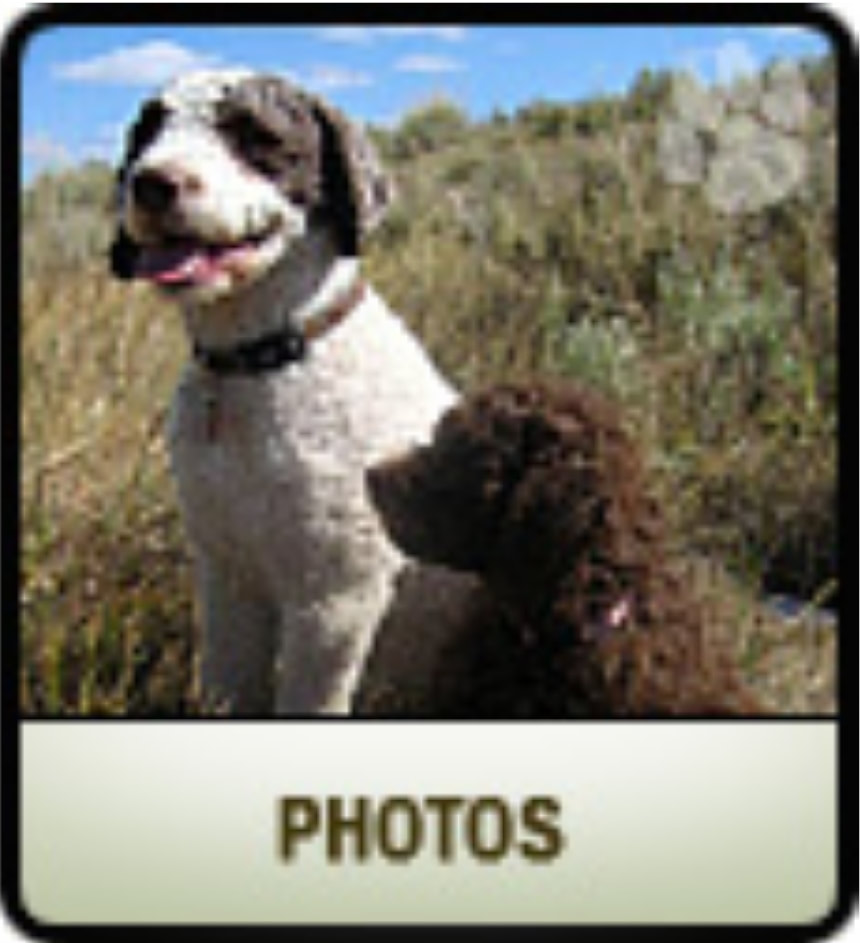Breed Information
General Information
Breed Name:
Spanish Water Dog, also known as Perro de Agua Español, Turco Andaluz, or Perro Turco.
General Description:
Spanish Water Dogs are medium sized with a distinctive curly coat that may form cords when long. They are slightly longer than tall. The Spanish Water Dog is a multi-functional, all-around farm dog. He is primarily a versatile herding dog who was used to gather, drive and pen sheep, goat, and cattle in it's native country (Spain) for centuries. Their natural ability is a derivative of the Spanish Water Dog's instinct to read stock and situations and react appropriately. The SWD has also been used as an assistant to the fisherman. Some have used the Spanish Water Dog as a hunting dog, although there is no historical documentation about what- or how they hunted. Many Spanish Water Dogs enjoy swimming and diving. They have webbed feet, like almost every other breed.
The Spanish Water Dog is a high energy dog best suited for an owner with an active lifestyle. They have strong herding and protective instincts, are very loyal to their owners and commonly wary with strangers. A Spanish Water Dog should never be shy or aggressive.
Spanish Water Dogs must be socialized beginning very early in their life. The Spanish Water Dog puppy should be exposed to many different people, animals and situations.
Mental stimulation is as important as physical exercise. The Spanish Water Dog should be provided tasks and new learning experiences to prevent it from becoming bored. The Spanish Water Dog thrives on human contact and are known to be "velcro" dogs. Although the Spanish Water Dog will make a good family dog, it will often attach itself to one member of the family. Some Spanish Water Dogs are wary of men and prefer women.
The Spanish Water Dog is usually not appropriate for first time dog owners, but is better suited to someone with previous dog experience. He responds best to positive training methods. While they are good with children, the Spanish Water Dog, because of its strong herding instincts, might not be suitable for very young children. In addition to being intelligent and eager, as a breed they can be quirky, inventive, strong-willed, moody, territorial, and manipulative. They are driven to participate in as many family activities as possible. It is up to you to make this participation constructive. Dog performance activities such as herding, agility, obedience, tracking, water work, hunting and flyball can help provide the physical and mental exercise a Spanish Water Dog requires.
The Spanish Water Dog will sometimes herd anything that moves. While chasing cars can be disastrous for the dog, when misdirected towards children the Spanish Water Dog's herding instinct can be problematic for the entire family. If the Spanish Water Dog decides that children are not obeying he might think that a nip is in order to discipline them. Many Spanish Water Dogs will react very quickly to stimulation, which can make them extremely sensitive to sudden sounds and movement
Size:
Male Spanish Water Dogs should be approximately: 44 to 50 cm (17.32 to 19.68
inches) tall at the withers, and between 18 to 22 kg (39.69 to 48.5 lbs) in weight.
Female Spanish Water Dogs should be approximately: 40 to 46 cm (15.75 to 18.11
inches) tall at the withers, and between 14 to 18 kg (30.86 to 39.69 lbs) in weight.
The Spanish Water Dog should be longer than it is tall. The following body ratios are a good rule of thumb for Spanish Water Dog proportions: Length of body/size (height at withers): 9/8; Depth of chest/size (height at withers): 4/8; and Length of muzzle/length of skull: 2/3.
withers.
Coat Type:
The Spanish Water Dog has a curly non-shedding coat that may naturally form cords. While the Spanish Water Dog is a low dander hypo-allergenic dog, there is no such thing as a non-allergenic dog. People with severe allergies should spend time with a Spanish Water Dog before making one part of their family to see if they have an allergic reaction. Some allergy sufferers are also allergic to the saliva.
Grooming:
The Spanish Water Dog generally requires little grooming. The coat should never be brushed or combed. At least once a year, the coat must be evenly sheared from the entire body, very similar to shearing a sheep – twice per year is not uncommon. During the phase in which the Spanish Water Dog’s coat begins to cord, more work is required to assist proper cording and to prevent the cords from matting near the skin. When bathing, a light, non-astringent shampoo should be used. The coat should not be towel dried after bathing, but rather should be “blotted” and permitted to drip or air dry so coat properly cords. No aesthetic haircuts are permitted – the dog should remain rustic in appearance.
Common Inherited Concerns:
In the past, very little information has been gathered concerning inherited health issues among Spanish Water Dogs. The United States and some European and Scandinavian Countries have recently been conducting health tests and keeping records . At this time, it appears that the biggest health issues in the breed are hip dysplasia and allergies. There have also been cases of glaucoma, prcd-PRA, Hypothyroid, Congenital Hypothyroid with Goiter and other potentially inherited defects among Spanish Water Dogs. Shyness has been a concern among the breed and there have been many reports of difficult temperaments in the breed. While the breed is known to be wary of strangers and protective of his family and property, shyness is not acceptable. Socialization can significantly improve a dog’s temperament, but it is not a substitute for proper breeding.
Breed Name:
Spanish Water Dog, also known as Perro de Agua Español, Turco Andaluz, or Perro Turco.
General Description:
Spanish Water Dogs are medium sized with a distinctive curly coat that may form cords when long. They are slightly longer than tall. The Spanish Water Dog is a multi-functional, all-around farm dog. He is primarily a versatile herding dog who was used to gather, drive and pen sheep, goat, and cattle in it's native country (Spain) for centuries. Their natural ability is a derivative of the Spanish Water Dog's instinct to read stock and situations and react appropriately. The SWD has also been used as an assistant to the fisherman. Some have used the Spanish Water Dog as a hunting dog, although there is no historical documentation about what- or how they hunted. Many Spanish Water Dogs enjoy swimming and diving. They have webbed feet, like almost every other breed.
The Spanish Water Dog is a high energy dog best suited for an owner with an active lifestyle. They have strong herding and protective instincts, are very loyal to their owners and commonly wary with strangers. A Spanish Water Dog should never be shy or aggressive.
Spanish Water Dogs must be socialized beginning very early in their life. The Spanish Water Dog puppy should be exposed to many different people, animals and situations.
Mental stimulation is as important as physical exercise. The Spanish Water Dog should be provided tasks and new learning experiences to prevent it from becoming bored. The Spanish Water Dog thrives on human contact and are known to be "velcro" dogs. Although the Spanish Water Dog will make a good family dog, it will often attach itself to one member of the family. Some Spanish Water Dogs are wary of men and prefer women.
The Spanish Water Dog is usually not appropriate for first time dog owners, but is better suited to someone with previous dog experience. He responds best to positive training methods. While they are good with children, the Spanish Water Dog, because of its strong herding instincts, might not be suitable for very young children. In addition to being intelligent and eager, as a breed they can be quirky, inventive, strong-willed, moody, territorial, and manipulative. They are driven to participate in as many family activities as possible. It is up to you to make this participation constructive. Dog performance activities such as herding, agility, obedience, tracking, water work, hunting and flyball can help provide the physical and mental exercise a Spanish Water Dog requires.
The Spanish Water Dog will sometimes herd anything that moves. While chasing cars can be disastrous for the dog, when misdirected towards children the Spanish Water Dog's herding instinct can be problematic for the entire family. If the Spanish Water Dog decides that children are not obeying he might think that a nip is in order to discipline them. Many Spanish Water Dogs will react very quickly to stimulation, which can make them extremely sensitive to sudden sounds and movement
Size:
Male Spanish Water Dogs should be approximately: 44 to 50 cm (17.32 to 19.68
inches) tall at the withers, and between 18 to 22 kg (39.69 to 48.5 lbs) in weight.
Female Spanish Water Dogs should be approximately: 40 to 46 cm (15.75 to 18.11
inches) tall at the withers, and between 14 to 18 kg (30.86 to 39.69 lbs) in weight.
The Spanish Water Dog should be longer than it is tall. The following body ratios are a good rule of thumb for Spanish Water Dog proportions: Length of body/size (height at withers): 9/8; Depth of chest/size (height at withers): 4/8; and Length of muzzle/length of skull: 2/3.
withers.
Coat Type:
The Spanish Water Dog has a curly non-shedding coat that may naturally form cords. While the Spanish Water Dog is a low dander hypo-allergenic dog, there is no such thing as a non-allergenic dog. People with severe allergies should spend time with a Spanish Water Dog before making one part of their family to see if they have an allergic reaction. Some allergy sufferers are also allergic to the saliva.
Grooming:
The Spanish Water Dog generally requires little grooming. The coat should never be brushed or combed. At least once a year, the coat must be evenly sheared from the entire body, very similar to shearing a sheep – twice per year is not uncommon. During the phase in which the Spanish Water Dog’s coat begins to cord, more work is required to assist proper cording and to prevent the cords from matting near the skin. When bathing, a light, non-astringent shampoo should be used. The coat should not be towel dried after bathing, but rather should be “blotted” and permitted to drip or air dry so coat properly cords. No aesthetic haircuts are permitted – the dog should remain rustic in appearance.
Common Inherited Concerns:
In the past, very little information has been gathered concerning inherited health issues among Spanish Water Dogs. The United States and some European and Scandinavian Countries have recently been conducting health tests and keeping records . At this time, it appears that the biggest health issues in the breed are hip dysplasia and allergies. There have also been cases of glaucoma, prcd-PRA, Hypothyroid, Congenital Hypothyroid with Goiter and other potentially inherited defects among Spanish Water Dogs. Shyness has been a concern among the breed and there have been many reports of difficult temperaments in the breed. While the breed is known to be wary of strangers and protective of his family and property, shyness is not acceptable. Socialization can significantly improve a dog’s temperament, but it is not a substitute for proper breeding.






